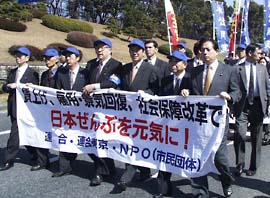|
Photo: Participants march at the National Rally to Break the Living Standard Crisis, Yoyogi Park, March 6.
 As
the situation now stands, on March 4, RENGO determined the following
at the 4th Central Struggle Committee held for the 1999 Spring Struggle. As
the situation now stands, on March 4, RENGO determined the following
at the 4th Central Struggle Committee held for the 1999 Spring Struggle.
1. The Progress of 1999 Spring Struggle
Taking into account the 3rd Urgent Policy at the 3rd Central Struggle Committee, RENGO held the 4th and the 5th of the Expanded Tactical Committees on February 23 and March 4 respectively and proceeded its struggle.
Each affiliated organization and its participating unions have been carrying on negotiations vigorously since the submission of their demands. RENGO is maintaining measures for the government and the Diet to achieve its demands for policies and systems regarding various problems such as employment, economic recovery, social security reform and labor legistration amendment, while tenaciously striving to gain understanding from employers' associations.
However, the gap between management and labor is significant since management still adheres to "zero pay increase" and "standard wage reductions" and does not respond to the labor's demand for a "1% wage increase" which was set in consideration of the microeconomic situation. It has come to the point that a much tougher push for management is necessary for RENGO and each affiliated organization to achieve their demands.
2. The 4th Urgent Plan
(1) According to information gathered as of March 9, entry members in the struggle total 6,654,642 workers in 16,163 unions from 61 organizations. Out of that number the private sector accounts for 5,498,893 workers in 13,324 unions from 58 organizations (partial overlap).
Unions pressing for answers by the end of the peak period that is from March 17 to 26, total 5,662 unions of 3,943,589 workers. A total of 6,572 unions consisting of 4,233,603 workers are pushing management for answers by the end of March. Further, according to an inquiry on strategic conditions, 2,999 unions are taking an a-priori deal, while 4,460 unions will take a post facto deal making for higher right-to-strike ratification rates than before.
(2) During the ten-day peak period of March 17-26, all RENGO affiliated organizations will seek answers and settlements from management. Other unions will also continue to gain a settlement by the end of March. Specifically major unions will intensify the arguments about the differential problem and support negotiations in cooperation with small to mid-sized unions.
(3) In order to achieve their demands, each affiliated organization will work on the following.
- Acceptable standards not yet verified at this point in time. Each affiliated organization and union will push management even more in an effort to realize demands supported by union members' expectations and higher right-to-strike ratification rates.
- Affiliated organizations will press for a set date for an answer to their demands, while working for labor-management relations and preparing for the worst case scenario. Specifically, every strike tactic, reserve answers, protest action, the utilization of labor committees and so forth will be brought into full play in dealing with raising the answer standards.
- To unify thoughts regarding tactics, RENGO will hold a new Tactical Subcommittee on March 14 in addition to its 2nd Tactical Subcommittee on March 11.
(4) March 23 through 31 has been set aside as a period of action for local and small to mid-sized unions to attempt to strengthen conditions to settle negotiations by the end of March. After that point, RENGO will ratify tactics at the 9th Expanded Tactic Committee on April 6 including setting compromise agreement standards and so forth.
1999 Demand for bonus' (see chart).
The private sector as of March 4.
|
|
Yearly |
Summer |
|
Weight
avg.
|
Month |
5.36 |
2.55 |
| Amount |
¥1,627,808 |
¥800,656 |
|
Simple
avg.
|
Month |
5.34 |
2.63 |
| Amount |
¥1,520,053 |
¥754,113 |
|
 As
the situation now stands, on March 4, RENGO determined the following
at the 4th Central Struggle Committee held for the 1999 Spring Struggle.
As
the situation now stands, on March 4, RENGO determined the following
at the 4th Central Struggle Committee held for the 1999 Spring Struggle.